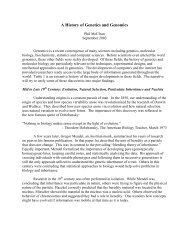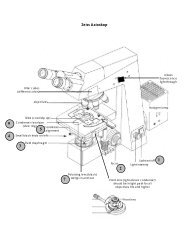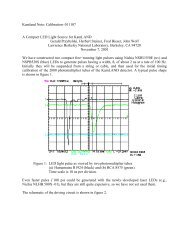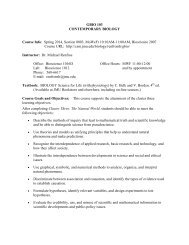Using Spartan to Calculate and Visualize Molecular Orbitals There ...
Using Spartan to Calculate and Visualize Molecular Orbitals There ...
Using Spartan to Calculate and Visualize Molecular Orbitals There ...
You also want an ePaper? Increase the reach of your titles
YUMPU automatically turns print PDFs into web optimized ePapers that Google loves.
<strong>Using</strong> <strong>Spartan</strong> <strong>to</strong> <strong>Calculate</strong> <strong>and</strong> <strong>Visualize</strong> <strong>Molecular</strong> <strong>Orbitals</strong><strong>There</strong> is more than one way <strong>to</strong> represent (<strong>and</strong> therefore recognize) a molecule.One could simply draw lines between a<strong>to</strong>mic symbols. Or try <strong>to</strong> sketch the threedimensionalshape of the molecule. Or represent, somehow, the bulk of itsa<strong>to</strong>ms, a so-called space-filling model. Or estimate the electric field emanatingfrom it. Or one (well, another molecule, that is) could ‘stroke’ the molecule.<strong>There</strong> are so many ways for us, or molecules <strong>to</strong> ‘see’ or ‘feel’ one another.Roald Hoffmann<strong>Molecular</strong> modeling can be used <strong>to</strong> provide accurate models for many aspects of moleculesincluding molecular size <strong>and</strong> shape, bond lengths <strong>and</strong> angles, relative energies of structures,the distribution of electrons in molecular orbitals, charge distribution <strong>and</strong> vibrational modes ofmolecules. These molecular models result from the application of the physics <strong>and</strong> mathematicsthat describe the behavior of chemical systems.In this exercise, you will investigate the distribution of electrons in molecules by calculatingmolecular orbitals for several molecules. While <strong>Spartan</strong> is a powerful program, it must be usedwith caution. The model you get out is only as good as the information that you provide <strong>to</strong><strong>Spartan</strong>. Underst<strong>and</strong>ing the mechanics of the calculations done by <strong>Spartan</strong> is non-trivial (<strong>and</strong>not completely unders<strong>to</strong>od by your instruc<strong>to</strong>rs). Before computational results are accepted asmodels that are described by reality, they need <strong>to</strong> be verified by experiment. In fact, empiricalevidence helps chemists <strong>to</strong> develop better modeling programs; it’s an iterative process. Yourinstruc<strong>to</strong>rs have selected problems that accurately reflect the world in which we live.Computational MethodsWhen doing calculations about the chemical properties of molecules, you need <strong>to</strong> make physicalassumptions about the molecules. <strong>There</strong> are several techniques used <strong>to</strong> calculate theproperties of molecules; each has its advantages <strong>and</strong> disadvantages. Generically, methods fallin<strong>to</strong> two class: classical (or New<strong>to</strong>nian) mechanical methods <strong>and</strong> quantum mechanical methods.• Classical (New<strong>to</strong>nian) Mechanical Models. <strong>There</strong> are two main techniques that useclassical mechanical models: molecular mechanics <strong>and</strong> molecular dynamics. From aclassical perspective, a molecule is modeled as a collection of hard spheres (nuclei) that areconnected by flexible springs (chemical bonds). <strong>Using</strong> classical models, electrons are notexplicitly included. This severely limits the use of classical calculations because it meansthat they cannot accurately describe any properties associated with electrons <strong>and</strong> electrondistribution. However, these methods are extremely powerful for doing conformationalanalysis (looking at bond lengths, angles, configurations) <strong>and</strong> the relative energies ofconformational isomers because these models can be used for molecules containingupwards of 1,000 a<strong>to</strong>ms. From a computational perspective, these calculations are alsoinexpensive.• Quantum Mechanical Models. Quantum mechanical methods fall in<strong>to</strong> two categories:semi-empirical methods <strong>and</strong> ab initio methods. Both techniques solve the Schrödingerequation for the molecule; they differ only in the approximations used. Because theelectronic structure of the compound is calculated, quantum mechanical methods lead <strong>to</strong> areasonable prediction of structure, theremochemical <strong>and</strong> electronic properties. In semiempiricalmethods, experimental data is used <strong>to</strong> mathematically describe a<strong>to</strong>ms. Ab initiomethods (implemented with Hartree Fock Methods <strong>and</strong> Density Functional Theory) do notdepend on empirical parameters. In these methods, appropriate mathematical forms that<strong>Spartan</strong> Calculations – Calculating <strong>and</strong> Displaing MOsPage 1BAR
describe the wavefunction of the a<strong>to</strong>mic orbitals of different elements have been developed.These have been developed so that computationally generated molecular structures agreewith experimental data. Semi-empirical methods are a bit less accurate but arecomputationally cheaper than ab initio methods. Hartree-Fock methods (ab initio) are bestapplied <strong>to</strong> organic compounds. Density Functional Models are relatively expensive but areparticularly useful for high-quality structure, energy <strong>and</strong> property calculations, includingcalculations on transition-metal inorganic <strong>and</strong> organometallic compounds.All of the methods described above are implemented in <strong>Spartan</strong>. The type of calculation can bechosen under Select Calculation.Calculating <strong>Molecular</strong> <strong>Orbitals</strong> <strong>Using</strong> <strong>Spartan</strong>MOs are very similar <strong>to</strong> the AOs that we use <strong>to</strong> describe an electron in an a<strong>to</strong>m (1s, 2s, 2p,etc.); they are different only because they describe electrons in molecules. Because MOsdescribe the location of electrons in molecules, quantum mechanical methods need <strong>to</strong> be usedfor calculation. For the inorganic molecules that we will be study, we will use semi-empiricalmethods with PM3 functions.To calculate molecular orbitals with <strong>Spartan</strong>, you must first construct your molecule. If you havean ion, be sure <strong>to</strong> set the Total Charge (under Setup Calculations). For molecular orbitalcalculations of inorganic molecules, your best bet is <strong>to</strong> calculate Equilibrium Geometry withHartree-Fock methods with the STO-3G basis set (see figure). If you are interested in therelative energy of your molecular orbitals, select <strong>Orbitals</strong> & Energies under Print.All orbital energies in <strong>Spartan</strong> are defined relative <strong>to</strong> the HOMO <strong>and</strong> the LUMO. The orbital thatis lower in energy than the HOMO is HOMO{-}. <strong>Orbitals</strong> that are higher in energy than theLUMO are called LUMO{+}. Unfortunately, <strong>Spartan</strong> does not have a way of naming degenerateorbitals. For example, if your HOMO is a doubly degenerate set of orbitals, they may be named<strong>Spartan</strong> Calculations – Calculating <strong>and</strong> Displaing MOsPage 2BAR
HOMO <strong>and</strong> HOMO{-} in spite of the fact that they are degenerate <strong>and</strong> in reality the setcompromises the HOMO. (In other words, you have <strong>to</strong> think; <strong>Spartan</strong> doesn’t do everything foryou.) If you are calculating MOs above the LUMO (LUMO{+}) or below the HOMO (HOMO{-}),you will have <strong>to</strong> select how far above the LUMO or below the HOMO the MO is. For example, ifI wanted <strong>to</strong> calculate the MO directly below the HOMO (in terms of energy), I would selectHOMO{-} 1. To get the most accurate picture of bonding in molecules, we will investigate allMOs that are constructed from valence orbitals whether they are filled or not.Let’s take a look at the dicarbide molecule, C 2 . (Before you draw this molecule in <strong>Spartan</strong>, drawthe correct Lewis structure. It may not be what you think!) Carbon is in the second row <strong>and</strong> has4 a<strong>to</strong>mic orbitals associated with its valence electrons (2s, 2p x , 2p y , 2p z ). Since there are twocarbon a<strong>to</strong>ms in dicarbide, there will be 8 a<strong>to</strong>mic orbitals associated with the molecules. If thereare 8 AOs going in<strong>to</strong> the construction of the MOs, we need <strong>to</strong> make 8 MOs. (That conservationof orbital rule is funny that way!) Next, we need <strong>to</strong> figure out how many orbitals are below theHOMO. Dicarbide will have a <strong>to</strong>tal of 8 electrons since each carbon a<strong>to</strong>m has four valenceelectrons. Assuming that all electrons are paired, there will be 2 electrons in the HOMO <strong>and</strong>three orbitals of lower energy than the HOMO will be needed <strong>to</strong> hold the other electrons. Inother words, we’ll need <strong>to</strong> generate HOMO, HOMO{-1}, HOMO{-2}, <strong>and</strong> HOMO{-3}. At thispoint, we’ve used 4 MOs. <strong>There</strong> are four more. They will be LUMO, LUMO{+1}, LUMO{+2},<strong>and</strong> LUMO{+3}. Next we need <strong>to</strong> have <strong>Spartan</strong> set up these MOs.To calculate MOs, select Setup Surfaces. An Add Surface window, similar <strong>to</strong> the one below,will appear.You will need <strong>to</strong> change the Surface <strong>to</strong> reflect the MO that you would like <strong>to</strong> calculate. Forexample, if you want <strong>to</strong> calculate the HOMO, the box will appear as shown below.<strong>Spartan</strong> Calculations – Calculating <strong>and</strong> Displaing MOsPage 3BAR
You will find it easiest <strong>to</strong> begin with the highest energy orbital. In the case of dicarbide, this isLUMO{+} 3. This is entered as LUMO{+} <strong>and</strong> 3 for Surface.Resolution can be left at medium. Changing the resolution will affect the precision <strong>to</strong> which<strong>Spartan</strong> calculates the surface of the MO. Visually, you will only notice changes for displayingthe surface in mesh mode. Increasing the resolution will also increase calculation time.You can select multiple surfaces <strong>to</strong> calculate. Once you have selected all surfaces <strong>to</strong> calculate,select Submit Calculations.Viewing MOsOnce you’ve calculated your MOs, you can look at their appearance by selecting theappropriate MO in the surfaces list.Let’s start with the lowest energy σ g (2s). When you click on the box next <strong>to</strong> HOMO{-3}, the MOwill appear on the molecule that you’ve constructed.<strong>Spartan</strong> Calculations – Calculating <strong>and</strong> Displaing MOsPage 4BAR
(If you take a close look at the bot<strong>to</strong>m right h<strong>and</strong> corner of the box, you can see the symmetry ofthe molecule. Dih st<strong>and</strong>s for D ∞h .) This is exactly what we expect – a molecular orbital with nonodes <strong>and</strong> electron density distributed between the two a<strong>to</strong>ms. The solid surface isn’tnecessarily the best way <strong>to</strong> view the molecule because it’s hard <strong>to</strong> see a<strong>to</strong>mic positions. Thesurface can also be viewed as a mesh grid, dots, or as a transparent surface. (The dots areamazingly hard <strong>to</strong> see on a prin<strong>to</strong>ut.)mesh grid dots transparent surfaceTo select the surface of interest, click on the surface. A box should appear in the bot<strong>to</strong>m righth<strong>and</strong> corner of your molecule window. Use the pull down menu <strong>to</strong> select the surface type.Now that your surface is there, you can start interpreting the meaning behind your molecularorbitals!<strong>Spartan</strong> Calculations – Calculating <strong>and</strong> Displaing MOsPage 5BAR













